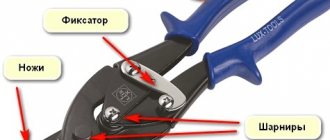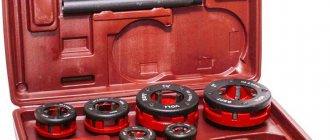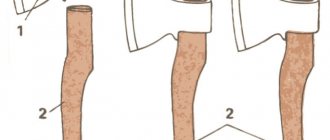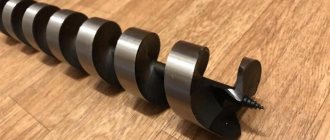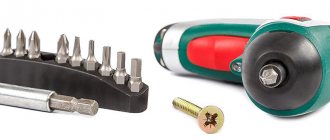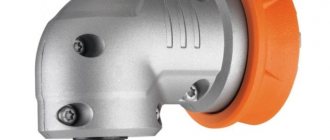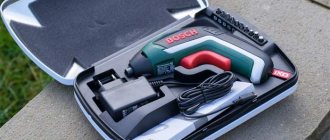A hand tool is a hand-held technical device that is used as a human or machine tool to perform certain jobs. It has a number of useful characteristics, is ergonomic and functional, and is widely used during work not only in the construction and repair sector, but also for domestic purposes.
Almost every home workshop begins with a collection of hand tools, collected over many months and even years by chance, without any plan or thought about the equipment of the workshop. When you have such an idea, the first thing you need to do is check what you already have and decide what you need to purchase additionally.
Types of hand tools
Depending on the type of work and purpose, hand tools can be grouped into the following groups:
- Clamping tool – acts as a holder for the material being processed, clamps it on both sides for convenient fixation (vise, clamps, clamps, etc.);
- A measuring instrument, the main purpose of which is to measure various readings: weight, dimensions, range, angle, etc. (levels, rangefinders, tape measures, squares, levels);
- Wrenches are tools for loosening/twisting bolts, nuts, pipes, etc. (spanners, combination wrenches, pipe wrenches, adjustable wrenches);
- Painting tools – for applying and distributing liquid mixtures on the surface (rollers, mixers, brushes); Screwdrivers – used for unscrewing and tightening screws and other fasteners (flat, Phillips, reversible screwdrivers);
- Specialized tool – a tool with a narrow purpose that performs specific functions (pipe cutters, glue/foam guns, riveters, etc.);
- Carpenter's tools - used in carpentry and metalwork (knives, hacksaws, saws, planes, chisels, miter boxes, axes, cutters, etc.);
- Impact-lever tools - tools for shaping and crushing materials, hammering, bending and removing all kinds of fasteners (hammers, sledgehammers, crowbars, nail pullers, picks, mallets, etc.);
- Pliers - designed for cutting and fixing materials (tongs, pliers, pliers, wire cutters, side cutters, metal scissors);
- Plastering tools - for applying and distributing thick pasty mixtures on the surface (spatulas, graters, scrapers, trowels, rules).
Malfunctions
In ready-made sets, handles often break and sets of attachments become unusable due to weakness of the metal, excessive load or mechanical damage.
The specificity of hand tools is such that self-repair is not practiced. Of course, you can straighten the slot one time, weld the attachment, or attach a tire to a broken handle, but this will inevitably affect the functionality of the tool.
Wear and tear of consumable parts is normal. A broken drill, tap or drill is replaced with similar elements. Unless the functional part of the tool is damaged, these parts are not eligible for warranty replacement.
How to choose the right hand tool
There are several factors to consider when choosing a hand tool. They are:
- material of manufacture;
- quality of processing;
- lever;
- connecting mechanisms;
- protective covering;
- manufacturer;
- price category;
- storage method.
The best material from which hand tools are made is steel with impurities of chromium and vanadium. The material has high strength and tolerates various loads well. This is the kind of inscription you should look for in your passport or on the hand tool itself. This steel is abbreviated as Cr-V. Such an inscription can appear on the body of a wrench or screwdriver. When it comes to screwdrivers, those with a magnetic tip are very convenient. Often it differs in color from the main sting. Working with such a tool is a pleasure, because after unscrewing, self-tapping screws do not get lost or get stuck in holes.
Any workshop is indispensable without hand tools - you will need them for most jobs. Here are the most necessary ones.
Types
The set consists of a tool box and its contents. Sockets, screwdrivers, bits, turning tools and wrenches included in a set are classified as parts.
The more parts a kit contains, the more versatile it is. The largest sets contain 500 or more elements.
Boxes are made of metal, plastic or other materials. Sizes range from small pencil cases to large racks on wheels. A common form is a tool case or suitcase.
The tool is grouped into thematic sets of three types:
- Universal, automotive or special kit. This is the most common gradation, which is used as a basis by most manufacturers.
- For car enthusiasts, small household needs and other serial work. These are household kits.
- A series of tools of the same type with different parameters. Most often, such kits are aimed at professional use. Attachments for power tools can also be grouped.
Household series differ from professional series. Home kits most often include a hammer, a pair of pliers and several screwdrivers. For automobiles - devices for minor car repairs.
The number of units of the set is limited to the elements that are necessary to perform most household tasks.
Professional models are made from alloy steel. Kits sometimes include batteries, multimeters, and fasteners in common sizes.
Wrenches and impact wrenches
The most common wrench is the 250mm adjustable plain end wrench, which grips nuts and bolt heads up to 25mm in size. There are also fixed jaw wrenches, which tighten nuts and bolt heads from the side, and socket wrenches, which fit on top of them. The latter are suitable for tightening and unscrewing nuts and hexagonal bolt heads. Universal wrenches combine both types. However, it is much more convenient to have separate sets of both types of wrenches, especially when you need two tools of the same size at the same time. Ratcheting socket wrenches speed up bolt tightening and make working in hard-to-reach areas easier.
Titles
The names of the tools indicate their functional purpose. Doctors from different countries often use Latin and ancient Greek names, for example, retractor, trocar, dermatome, scarifier. Many instruments have both Latin and Russian names:
- terminal and clamp,
- dilator and dilator,
- elevator and lift.
In surgery, it is also customary to add the names of their inventors to the names of instruments: Buyalsky's scapula, Pean's arterial clamp, Payr's press, Allis's forceps, Voyacek's chisel. Most honey instruments have these names.
There are a lot of tools; for example, there are about a hundred tweezers alone. Therefore, any special names that make it easier to remember are welcome. For example, “bulldogs” or “dogs” – soft vascular clamps, a “mosquito” clamp.
Measuring devices
Indispensable things in the workshop are a ruler and a tape measure. Some tape measures have a durable casing to accommodate spare tapes. It is also advisable to purchase a 1 m long ruler made of solid wood. It would be good if it had protective brass linings at the ends. Construction pencils are used to mark the workpieces. They leave clear lines on wood, concrete, metal and other materials. Permanent industrial markers and marking chalk are also useful. Vernier calipers are a universal tool designed for high-precision measurements of external and internal dimensions, as well as hole depths. Its simple design makes the caliper easy and convenient to operate. During construction and repair work, a level is required - a device with which the deviation of the surface from the horizontal or vertical plane is determined. The most common type of level is a bubble level with two eyes: vertical (90 degrees) and horizontal (180 degrees). For more complex work, a stirrup tool is used with eyes: the third flask measures 45 degrees from the horizontal plane fixedly or is rotatable to measure any angle of the surface. A laser level is much more expensive than a bubble level. With this help you can significantly speed up the process of measuring planes. However, for a home workshop, purchasing such an expensive tool is often not justified.
Functions
The functions of the kits correspond to their names.
- Universal - used for household or professional needs. More often these are maximum sets, consisting of a large number of elements for all occasions.
- Cars - serve as a basic tool for preventative maintenance and minor car repairs and as an auxiliary tool for changing wheels, installing alarms and car radios.
- Special - special sets are not universal, they are selected strictly according to the type of application, according to which they are completed. Responsible delicate work is often impossible to carry out without using this type of tool.
Universal and autodialer are partially interchangeable.
The tool present in special kits is extremely rare in other kits.
Hammers
The hammer is one of the oldest tools used by man. There are many modifications of it. A hammer with a hardened head and a round striker is designed for working with metalworking chisels and shaped metal processing. A hammer with a curved forked end in the form of a gripper pulls out nails without effort, but for disassembling structures connected by nails, it is better to use a model with a straight forked end. The cross hammer has a straight hammer instead of a nail hammer and is used to guide the nail, which is held between the fingers. In a smaller version, this hammer is ideal for fastening panel studs. For sheet metal work, as well as woodwork, a wooden hammer with two heads is used (mallet) and replaceable rubber and plastic heels.
For heavier wood chisel work, use a regular wooden hammer with a square head. The best heads for nail pullers and round hammers are made from steel forgings: they are seamless and highly polished. Hammer handles also vary in weight, with the most common being 450, 570 and 680 grams.
Classification of cutters for turning
The classification of turning tools is regulated by the requirements of the relevant GOST. According to the provisions of this document, cutters are classified into one of the following categories:
- one-piece tool made entirely of alloy steel. There are also cutters that are made entirely of tool steel, but they are used extremely rarely;
- cutters, onto the working part of which a plate made of hard alloy is soldered. Instruments of this type are most widespread;
- cutters with removable carbide plates, which are attached to their working head using special screws or clamps. Cutters of this type are used much less frequently compared to instruments of other categories.
Basic concepts regarding the operation of a turning cutter and its main angles (click to enlarge)
Cutters also differ in the direction in which the feed movement is made. Yes, there are:
- left-hand turning tools - during processing they are fed from left to right. If you place your left hand on top of such an incisor, then its cutting edge will be located on the side of the bent thumb;
- right incisors - the type of tool that has become most widespread, the feed of which is carried out from right to left. To identify such a cutter, you need to place your right hand on it - its cutting edge will be located, accordingly, on the side of the bent thumb.
Difference between left and right incisors
Depending on what work is performed on turning equipment, cutters are divided into the following types:
- for finishing metal work;
- for rough work, which is also called roughing;
- for semi-finishing work;
- for performing delicate technological operations.
File and rasps
A file is a multi-edged tool for processing metals, wood, and plastics. This is a metal rod made of tool steel, onto which a notch is applied, which can be of different frequency (lumber, bastard, personal, velvet) and character (simple - for non-ferrous metals; cross - for steel, cast iron and bronze; milled - for non-ferrous metals and wood; rasp - for wood, leather, rubber).
There are small files for fine work, coated with diamond powder - needle files. They are used for processing hardened steel, glass, and ceramics. A useful addition to a file would be a wooden or plastic handle that can be easily removed from one tool and put on another. A stiff wire brush will also be useful to clean the notch.
A type of file is a rasp - a file with the largest notch. It is a cutting tool and is often called a "carpenter's file." Unlike a file, a rasp has a notch in the form of separately located projections or teeth. Rasps are used for processing soft materials: wood, drywall, plastic, rubber, leather - where a regular file quickly becomes clogged with shavings and stops cutting. The rasp is also suitable for working with soft metal and stone. It is best to use a rasp to level and smooth the ends, edges and holes of products.
Exploitation
Maintenance of hand tools is subject to a set of operating rules:
- Before first use or storage, it is recommended to lubricate moving parts and components.
- For air attachments, use only sewing machine or air tool oil.
- Kerosene is used to clean working parts from carbon deposits.
- After washing, the instrument should be wiped dry.
- It is unacceptable to use gasoline or alcohol-containing liquids for cleaning.
- Avoid getting flushing liquids into working mechanisms.
If any malfunctions are detected, stop using the tool and contact an authorized service center.
Security measures:
- Before work, you need to make sure that the tool has no mechanical damage.
- You should make sure that clothing or hairstyle does not come into contact with moving mechanisms and components.
- Wear safety glasses when drilling or drilling.
- The tool may only be used for its intended purpose.
- Exploitation by people under the influence of alcohol or drugs is unacceptable.
Only impact socket models are used with pneumatic tools. The use of attachments for hand tools is unacceptable.
Tool storage
Kits should be stored in a clean, lubricated and dry condition. Use standard cases, pencil cases or boxes that come with the kit.
It is advisable to carry out preventive anti-corrosion treatment and lubricate the elements before each use.
Storage in rooms with high humidity is unacceptable.
Screwdrivers
A screwdriver is a hand-held mechanic's tool designed for screwing and unscrewing threaded fasteners (most often screws and screws) that have a slot (groove) on the head. Typically a screwdriver is a metal rod with a tip and a plastic or wooden handle. Any tool collection should have at least four flat-head screwdrivers for single-head screws and two different-sized Phillips-head screwdrivers for Phillips-head screws. The best insulation for screwdrivers used in electrical work is rubber-coated plastic handles. A twist screwdriver with a ratcheting mechanism that converts the translational movement of the handle into the rotating movement of the screwdriver slot will greatly speed up jobs that require installing or removing large numbers of screws. The optimal size of such a screwdriver is 50 mm. Universal screwdrivers are also produced, which are a handle to which you can attach (using a collet clamp, hex or square slot) a whole set of tips (bits) for different types and sizes of slots.
Peculiarities
Basic features depend on the type of kit you prefer. In each case they are individual and may be present in minor details:
- Comfortable handles for long-term use. The presence of threads, rubberized pads, and ergonomic design do not play a role in rare and short-term use, but for long-term or constant work these are the defining features.
- The versatility of the butt joints, the ability to replace them with similar parts from other manufacturers, and the tightness of the threaded connections are features that determine the ease of use of the kits in work.
Most kits meet these requirements, but if there is an exception, it is worth re-evaluating the purchase prospects.
- Anti-corrosion protective coating - significantly extends the service life of the tool. Models without it leave marks on hands and finishing materials a short time after the start of use.
The features of the kits are not divided by type, since their use is determined by work needs. But medium-sized universal kits are often produced in the highest quality.
Saws
A saw is a tool with many cutters for cutting various materials: wood, metal, plastic, stone, etc. Usually the saw has the form of a metal plate with teeth on the working edge. However, there are saws whose edges are made in the form of an abrasive (for example, diamond - for cutting stone) coating, or in the form of a set of elements, like chain saws.
By design, hand saws are divided into bow saws (a thin blade is stretched between two holders) and hacksaws (the blade has sufficient strength and elasticity to hold its shape), as well as one-handed and two-handed.
There are also five main types of saws: rip saws and cross saws. Used for cutting along and across the fiber; reverse hacksaw. Used in devices for cutting at an angle of 45 degrees; jigsaws and scoring saws. Suitable for cutting along curved lines.
All saws should have polished blades to prevent friction from interfering with the cutting of wood. Large crosscut and rip saw blades should be sharpened to a wedge, i.e. they must be processed so that the blade of the teeth is thicker at the bottom than at the top. All teeth should be the same distance from each other. Large saws should have five removable clamps that secure the handle to the blade.
Hand saws are classified according to their purpose: for wood. Large teeth cut wood more efficiently, but leave a rough cut; the middle ones cut more slowly, but their cut is cleaner; small ones cut cleanly, but very slowly; on metal. This saw is commonly called a hacksaw. It has a narrow, replaceable sheet stretched between the ends of a U-shaped metal bracket; on cellular concrete. This saw is Teflon coated and carbide tipped on every second tooth.
Depending on the material for which the saw is intended, the optimal shape, length and width of the teeth is selected. To prevent jamming, the saw teeth are set in different directions through one (less commonly, “triple set” is used), which widens the cut. For the same purpose, the teeth are shaped into a trapezoid or riveted.
Problems
Disadvantages are also divided according to the type of set:
- Automotive variations contain elements only for simple components. Standard parts will not help you repair even a minor breakdown of a specific vehicle component on your own.
- Universal series contain many unnecessary components that will never be useful. The quality of such sets is rarely found at a decent level.
- Special variations are practically inapplicable for everyday needs. If purchased without a professional need, they often do not pay for themselves.
There are no critical shortcomings in different types of sets. They appear only due to the reduced quality of the instrument.
Planers
A planer is a hand-held woodworking tool for planing. Using a plane, they impart the desired roughness to the surfaces of wooden parts, making them flat and straight. Planers are also used to reduce the size of parts and create long recesses of various shapes in them. With each passage along the surface, this tool cuts off a layer of material with a thickness determined by the amount of extension of the cutter, as well as its angle of inclination.
The most necessary planes in a home workshop are an end plane for trimming the edges of wood and a jointer for longitudinal planing. These tools have high-quality steel knives and adjusting mechanisms that regulate the amount of wood removed. You can also supplement your tool kit with a sherhebel for straightening the edges of long boards; a chisel for cutting grooves; carpenter's scraper for cutting and smoothing curved surfaces.
Advantages
The advantages of hand tools correspond to their types:
- Car kits are suitable for most routine maintenance work and eliminate the need to go to a car service center for minor breakdowns; they are indispensable on the road.
- Universal series are convenient with an abundance of shapes, sizes and functional elements. The main advantage is the interchangeability of individual components.
- Special kits are designed for professional use. As a rule, they do not contain unnecessary elements. Each component is usable for the job.
The basic advantage of any set over a separate, albeit high-quality, tool is the ability to flexibly select it for a specific task without the need to visit a hardware store if some detail is missed.
The kit contains basic parts and attachments at hand.
Cigar Box Guitar (CBG)
As the name suggests, these are guitars made from cigar boxes, whose history began in the USA over 160 years ago. The fact is that in the 19th century in the USA, cigars transported in wooden boxes made of fairly good wood were very popular. When the box became empty, it was thrown away. Black slaves took advantage of this and began using cigar boxes as guitar bodies. Cigar boxes quickly gained popularity among ordinary Americans and became a national musical instrument in the United States. Cigar boxes were used in their work by such legendary musicians as BBKing, Chuck Berry, Paul McCartney and others. Every year in the USA, Canada, France, Germany and the UK, cigarbox guitar festivals are held, which are attended by thousands of people, which suggests that this instrument is alive and still arouses interest and gathers its fans.
What does he do?
After completing the training and receiving the appropriate rank, the now qualified specialist begins to carry out the work assigned to him.
This may include the following tasks:
- Metalworking of parts prepared for this process;
- Conducts high-quality processing and repair of devices that are specified in the permit;
- Involved in the process of hardening the finished tool;
- Manufactures tools in accordance with technical specifications;
- Engaged in servicing the machine on which he works;
- Conducts tool testing within its own competence.
Stalactite organ
The instrument, created by nature and Leland Sprinkle, is located in Luray Cave in Virginia. Having appreciated the special acoustics of the cave, Sprinkle spent a long time studying the sound of every corner of the cave. As a result of his acoustic experiments, he applied small hammers to individual elements of the cave, which were controlled by an electronic keyboard.
Sakuleita
The sakuleita is an ethnic musical instrument that is a hybrid of the Japanese bamboo pipe (sakuhachi) and the European silver flute. The instrument was made in 2002 by sakuhachi maker Monty Levenson: he placed the upper end with a wedge from a Japanese bamboo flute into the bell of a European orchestral flute.
Didgeridoo (Australian trumpet)
This is a traditional Australian Aboriginal wind instrument. Termites eat away the core of long eucalyptus tree trunks, creating a cavity inside. The Aborigines find such trunks, clean the debris inside and equip the pipe with a mouthpiece made of beeswax. Then the instrument, which can reach three meters in length, is decorated with drawings. The basis of playing the didgeridoo is the technique of continuous breathing - simultaneous exhalation through the mouth while inhaling through the nose. Traditionally, the instrument was used as an accompaniment during rituals to help shamans enter into a trance. Contemporary performers of ambient, electronic, ethnic and other genres are experimenting with the didgeridoo.
Wrist magnetic bracelet for hardware
Finally, humanity has created the most useful accessory for builders. It’s hard to remember how many screws and nails I’ve lost because I had to hold them in my hands or throw them in my pockets. Now this problem has been solved simply and effectively - they have created a magnetic bracelet for hardware.
It weighs only 62 grams with dimensions of 9.3 * 34 * 0.4 cm. Made from high-quality 1680D Oxford fabric, which allows the hand to breathe and does not harm it, so you can safely work all day and not be afraid that irritation will appear on your hand .
In order for the hardware to hold tightly, it is enough to attach them to the bracelet and go about your work. Screws and nails will not get lost, and work will become much more convenient. It’s not for nothing that they say that everything ingenious is simple. The price of such a thing is only 360 rubles.
Areas of use
The scope of application of cutting tools is very extensive. Most of the products are found in mechanical engineering, since the workpieces are represented by various alloys. Considering the scope of application, we note the following points:
- Most products can cut metal only if a large force is transferred when the workpiece is rigidly secured. That is why they are manufactured in such a way that they can be installed in machines and other similar equipment. Scope of application: industry with varying levels of labor productivity. A distinctive feature of this group is its long service life and wear resistance.
- Processing of workpieces can also be carried out in a home workshop. For such a case, design options that are used for manual processing or the use of desktop equipment are suitable. Experts recommend choosing low-price options for your home workshop. This is due to the fact that they are excellent for machining at low feed rates and cutting speeds. Cutting tools for industrial machines are much more expensive and require professional periodic sharpening.
In general, we can say that the scope of application of cutting tools is very extensive. Mechanical cutting can only be carried out if there is a cutting edge.
Scope of application of the device
The main area of use of this type of tool is the construction sector. It is an almost indispensable device (practically, since a long bubble level can be used instead) when leveling solutions applied to the surface of a wall when plastering it. This device is no less in demand when pouring concrete on the floor, when in the end it is necessary to obtain the most even surface possible. However, this is not all types of work for which the building rule applies. It is also used to solve the following problems:
- marking - when it is necessary to draw a straight and even line of great length;
- emphasis when cutting glass - how to use a glass cutter, and how important it is to use straight metal strips, you can read here;
- an auxiliary tool when determining the level of surface slope - small bubble levels are not suitable for determining the evenness of large surfaces. In order not to buy a long level, you should use an auxiliary tool - a rule;
- installation of beacons for subsequent plastering of walls;
- level when laying tiles - unevenness is determined by the presence of a gap between the surface and the edge of the tool;
- ruler when working with a construction knife or pencil.
When performing any type of construction work, this type of tool will always be useful, because its main advantage is the perfectly flat plane of the sides. It should be noted that building regulations come in different sizes, so when choosing this type of tool, you must first determine the size of the room.
This is interesting! The most popular models of the rules are devices with a length of 1.5 and 2 meters. Their maximum length is up to 3 meters.
Although a flat wooden slat or a long level can be used to level the liquid solution, the work is usually more comfortable and efficient. This is due to the specific design of the tool, where there is an acute angle that should be used to remove excess solution. Separately, it is worth noting the low weight of the device, which eliminates not only the fatigue of the master during long-term work, but also the possibility of removing excess plaster.
A perfectly flat plane allows you to evenly distribute the mixture on the surface of the wall or floor. This is achieved by passing the rule over the surface of the liquid solution, cutting off the excess amount of the composition. The consequence of this procedure is to obtain a flat plane that can be used for laying tiles, laminate or other types of building materials.
The rule is more often used during construction and repair work. However, the tool is also in demand among craftsmen involved in the production and assembly of furniture. Carpenters use tools to end up with straight pieces of wood.
This is interesting! An undeniable advantage of modern rules is their long service life. After all, aluminum is not subject to corrosion, like metal, and does not deform from moisture, like wood.
